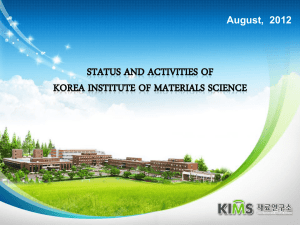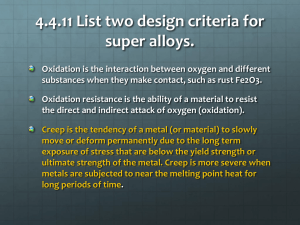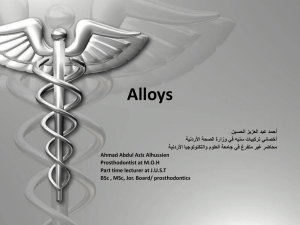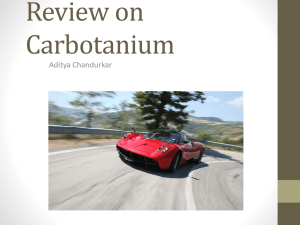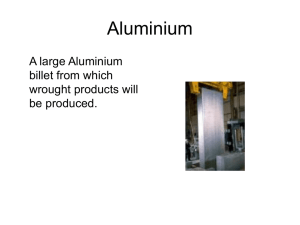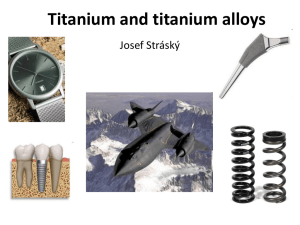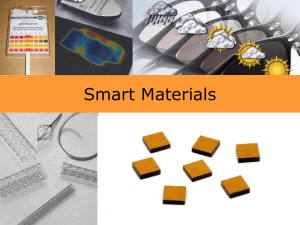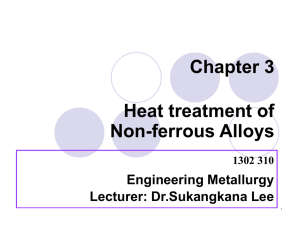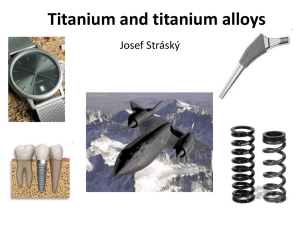Material properties requirements, for metallic materials
advertisement
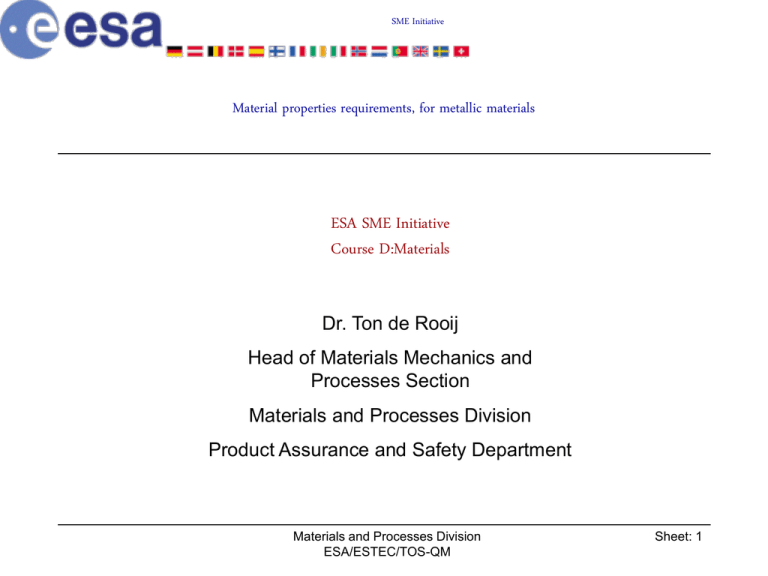
SME Initiative Material properties requirements, for metallic materials ESA SME Initiative Course D:Materials Dr. Ton de Rooij Head of Materials Mechanics and Processes Section Materials and Processes Division Product Assurance and Safety Department Materials and Processes Division ESA/ESTEC/TOS-QM Sheet: 1 SME Initiative Constraints on materials Temperature Vacuum Thermal cycling Chemical (corrosion) Galvanic compatibility Atomic oxygen Moisture absorption/desorption Fluid compatibility Materials and Processes Division ESA/ESTEC/TOS-QM Sheet: 2 SME Initiative Constraints on materials, cont… Temperature The range of temperatures experienced will play a large part in the materials selection. Extremes are illustrated by the examples of cryogenic tanks and thermal protection systems for re-entry applications. Temperatures below room temperature generally cause an increase in strength properties, however the ductility decreases. Ductility and strength may increase or decrease at temperatures above room temperature. This change depends on many factors, such as temperature and time of exposure. Materials shall be compatible with the thermal environment to which they are exposed. Passage through transition temperatures (e.g., brittle-ductile transitions or glass transition temperatures including the effects of moisture or other phase transitions) shall be taken into account. Materials and Processes Division ESA/ESTEC/TOS-QM Sheet: 3 SME Initiative Constraints on materials, cont… Thermal cycling Thermal cycling can induce thermal stresses and due to the difference in coefficient of thermal expansion between fibres and matrix for composites and between base metal and coating micro-cracks can form which could jeopardise long-term properties. Materials subject to thermal cycling shall be assessed to ensure their capability to withstand the induced thermal stresses and shall be tested according to ECSS- Q- 7004. Chemical (corrosion) The chemical environment to which a material is subjected in its life span may cause changes in the material properties. Corrosion is the reaction of the engineering material with its environment with a consequent deterioration in properties of the material. Corrosion will include the reaction of metals, glasses, ionic solids, polymeric solids and composites with environments that embrace liquid metal, gases, non-aqueous electrolytes and other nonaqueous solutions, coating systems and adhesion systems. Materials and Processes Division ESA/ESTEC/TOS-QM Sheet: 4 SME Initiative Constraints on materials, cont… Galvanic compatibility If two or more dissimilar materials are in direct electrical contact in a corrosive solution or atmosphere galvanic corrosion might occur. The less resistant material becomes the anode and the more resistant the cathode. The cathodic material corrodes very little or not at all, while the corrosion of the anodic material is greatly enhanced. • Material compatibilities shall be selected in accordance with ECSS- Q-70-71, • Maximum potential differences shall be in accordance with ECSS- Q-70-71, In the construction of a satellite, two metals that form a compatible couple may have to be placed in close proximity to one another. Although this may not cause anomalies or malfunctions in the space environment, it has to be borne in mind that spacecraft often have to be stored on earth for considerable periods of time and that during storage they may inadvertently be exposed to environments where galvanic corrosion can take place. In fact, this is known to have taken place on several occasions and it is for this reason that the Agency has been studying the dangers involved. Materials and Processes Division ESA/ESTEC/TOS-QM Sheet: 5 SME Initiative Constraints on materials, cont… Materials and Processes Division ESA/ESTEC/TOS-QM Sheet: 6 SME Initiative Constraints on materials, cont… Atomic oxygen Spacecraft in low earth orbit (LEO) at altitudes of between 200 km and 700 km are exposed to a flux of atomic oxygen. The flux level varies with altitude, velocity vector and solar activity. The fluence levels vary with the duration of exposure. Moisture absorption/desorption The properties of composite materials are susceptible to changes induced by the take-up of moisture. Moisture absorption occurs during production of components and launch of the spacecraft, desorption occurs in the space vacuum. Fluid compatibility In some occasions materials are in contact with liquid oxygen, gaseous oxygen or other reactive fluids or could come into contact with such a fluid during an emergency situation. Materials and Processes Division ESA/ESTEC/TOS-QM Sheet: 7 SME Initiative Metallic Materials used in space Light metals, such as beryllium, magnesium, aluminium and titanium and their alloys Steels, such as low-alloy, tool, corrosion resistant, precipitation hardable, and maraging Nickel and nickel base alloys, including pure nickel, Monel alloys, Inconel alloys, and other nickel- and cobald-base superalloys Refractory metals, principally niobium and molybdenum Copper-base alloys, including pure coppers, beryllium coppers, bronzes and brasses Precious metals Welding, brazing and soldering alloys Various plating alloys Materials and Processes Division ESA/ESTEC/TOS-QM Sheet: 8 SME Initiative Aluminium and its alloys Aluminium alloys are some of the basic building materials of existing spacecraft and appear in many subsystems. Light alloys based on aluminium are used in: primary and secondary structures; plumbing; plating in many applications (electronics, thermal control, corrosion protection etc); aluminised layers on other materials (see 'adhesive tapes' and 'plastic films'); fillers in other materials to provide electrical or thermal conductivity. In addition to standard alloys, more recent alloy developments include: additions of lithium to increase mechanical performance and decrease density. Li-additions are often lower than other 'conventional' alloying elements, so Al-Li alloys may appear within different alloy groups (2000-, 7000- and 8000-series wrought products). reinforced alloys (metal matrix composites - MMC) consisting of aluminium alloys reinforced with whiskers, metal wires, boron fibres or carbon fibres. thin Al-alloy sheets with layers of fibre-reinforced polymer composite in between (Fibre Metal Laminates - FML). Materials and Processes Division ESA/ESTEC/TOS-QM Sheet: 9 SME Initiative Aluminium and its alloys, cont… Main categories A large number of commercial, wrought and cast, alloys are available. A similarly large number of mechanical and thermal tempers are used to optimise certain properties, often at the expense of others (e.g. higher strength, but poorer corrosion resistance). Not all of these alloys or tempers are suitable for aerospace engineering, from the point of view of either mechanical performance or environmental resistance. Many aluminium alloys exhibit excellent corrosion resistance in all standard tempers. However, the higher-strength alloys, which are of primary interest in aerospace applications, must be approached cautiously. In structural applications preference should be given to alloys, heat treatments and coatings which minimise susceptibility to general corrosion, pitting, intergranular and stress-corrosion cracking. Some alloys are clad with thin layers of pure aluminium to improve corrosion performance. Materials and Processes Division ESA/ESTEC/TOS-QM Sheet: 10 SME Initiative Aluminium and its alloys, cont… Processing/Assembly All classical methods find a use: shaping and forming processes (wrought products produced by rolling, extrusion, forging; cast products); joining by welding, brazing, riveting, bolting, adhesive bonding etc. Not all alloys are weldable . Most high-strength alloys cannot be brazed. Space use does not raise special problems in this respect; except that processes must be extremely reliable. Aircraft industry standards are normally followed. Processing of metals gives rise to residual stresses that may cumulatively reach designstress levels, particularly as regards fatigue phenomena. Materials and Processes Division ESA/ESTEC/TOS-QM Sheet: 11 SME Initiative Aluminium and its alloys, cont… Precautions The properties of aluminium alloys are strongly dependent on their previous thermal and/or mechanical history. Residual stresses from processing (forming and heat-treatments), machining, assembly (improper tolerances during fit-up, over-torqueing, press-fits, high-interference fasteners and welding), operational use, storage and transportation need evaluation Corrosion must be considered during the whole manufacture and prelaunch phase; electrolytic couples should be avoided and all metals should be suitably protected against external damage by the use of plating, conversion coatings, paints and strippable coatings. This is particularly important in special operating environments (fuel tanks for example). Materials and Processes Division ESA/ESTEC/TOS-QM Sheet: 12 SME Initiative Aluminium and its alloys, cont… Stress Corrosion The metallic components proposed for use in most spacecraft must be screened to prevent failures resulting from SCC. Such metal-alloy selection must in particular be applied during the design phases of all spacecraft making use of the: Space Shuttle items intended for long-term storage prior to launch highly stresses structures all parts used or associated with the fabrication of launch vehicles, etc. Materials and Processes Division ESA/ESTEC/TOS-QM Sheet: 13 SME Initiative Aluminium and its alloys, cont… Stress Corrosion, cont… Stress corrosion cracking (SCC), defined as the combined action of sustained tensile stress and corrosion, can cause premature failure of aluminium alloys. Because metallurgical processing of aluminium alloys usually results in a pronounced elongation of grains, the variation of susceptibility with grain orientation is more extensive than for other metals (see ECSS-Q-70-36). Because conventional processing are designed to optimise strength, residual stresses especially in thick sections - are usually greater in aluminium products than in wrought forms of other metals. Both the residual stress distribution and the grain orientation shall be carefully considered in designing a part to be machined from wrought aluminium. Wrought heat-treatable aluminium products should be mechanically stress-relieved (TX5X or TX5XX temper designations) whenever possible. Materials and Processes Division ESA/ESTEC/TOS-QM Sheet: 14 SME Initiative Aluminium and its alloys, cont… Stress Corrosion (table I), cont… Wrought 1, 2 Alloy 1. Mechanical stress relieved (TX5X or TX5XX) where possible. Cast Condition Alloy Condition 1000 series All 355.0, C355.0 T6 2011 T8 356.0, A356.0 All 2024, rod bar T8 357.0 All B358.0 (Tens-50) All 359.0 All 2219 T6, T8 (E) 2419 T8 (E) 2618 T6, T8 380.0, A380.0 As cast 3000 series All 514.0 (214) As cast 5 5000 series All 4, 5 518.0 (218) As cast 5 6000 series All 535.0 (Almag 35) As cast 5 (E) 7020 T6 6 7049 T73 7149 T73 7050 T73 7075 T73 7475 T73 A712.0, C712.0 As cast 2. Including weldments of the weldable alloys. 3. The former designation is shown in parenthesis when significantly different. 4. High magnesium content alloys 5456, 5083 and 5086 should be used only in controlled tempers (H111, H112, H116, H117, H323, H343) for resistance to stress-corrosion cracking and exfoliation. 5. Alloys with magnesium content greater than 3.0% are not recommended for high-temperature application, 66°C (150°F) and above. 6. Excluding weldments. (E)ESA classification - not in NASA MSFC-SPEC-522A. Materials and Processes Division ESA/ESTEC/TOS-QM Sheet: 15 SME Initiative Aluminium and its alloys, cont… Hazardous/precluded Certain alloys and tempers are unsuitable for structural applications in long-term, manned structures, such as International Space Station (ISS): Some 5000-series alloys and tempers are limited to a maximum use temperature of 66C in ISS. Some 5000-series alloys with a high magnesium content require specific tempers to provide resistance to stress-corrosion cracking and exfoliation. Porous platings (corrosion protection) and aluminised layers are not permitted, because they fail to provide adequate protection and can act as sources for contamination (See also: Tapes and films). Electrolytic couples must be avoided or corrected by a suitable insulation between the metals concerned. Bare metal-to-metal contact is to be avoided in any moveable part. Materials and Processes Division ESA/ESTEC/TOS-QM Sheet: 16 SME Initiative Aluminium and its alloys, cont… Effects of space environment In general, metals do not suffer from space-environment conditions. Vacuum does not affect aluminium alloys. All metals in contact under vacuum conditions or in inert gas have a tendency to cold weld. This phenomenon is enhanced by mechanical rubbing or any other process which can remove oxide layers. Radiation at the level existing in space does not modify the properties of metals. Temperature problems are analogous to those encountered in technologies other than space, except for a complication arising from the difficulty of achieving good thermal contact in vacuum and due to the absence of any convective cooling. Aluminium alloys with magnesium contents greater than 3% are not recommended for applications where temperatures may exceed 66ºC. Atomic oxygen in low earth orbit (LEO) does not degrade aluminium alloys. Materials and Processes Division ESA/ESTEC/TOS-QM Sheet: 17 SME Initiative Copper and its alloys General Copper and copper-based alloys are established materials in electrical, electronic and also in more general engineering applications (such as bearing assemblies, etc). Not all are acceptable for space, so discussion is limited to those alloys which have been evaluated and to specific comments relating to their use in space. Use in spacecraft The main applications for copper are in electrical/electronic subsystems (wiring, terminals in soldered assemblies) and plating (electronics, thermal control, corrosion protection etc). Copper is also used as a metallising coating -see Plastic Films - and as an additive in other materials see Lubricants. Materials and Processes Division ESA/ESTEC/TOS-QM Sheet: 18 SME Initiative Copper and its alloys, cont… Main categories Copper materials are generally grouped as: commercially pure grades, of which there are many different 'named' varieties that indicate the manufacturing method and the level of control of impurities, including oxygen; alloys in which the alloying additions affect the metallurgical microstructure and consequently their characteristics (mechanical, electrical and thermal properties, environmental resistance). The main alloying addition generally provides the named classifications: • brass: copper - zinc alloys, often containing other alloying elements, such as lead which acts as a 'lubricant' for machining operations - so-called 'free-machining'; • bronze: copper - tin alloys, often containing other alloying elements. Electronic assemblies use wires made of high-purity copper or copper alloy and terminals of copper alloy. Beryllium-copper (also known as copper-beryllium) is a copper alloy with small additions of Be. These alloys are used for electrical/electronic applications (spring contacts); for low temperature applications; for high-strength corrosion resistant components and in safety applications in hazardous environments (no sparks produced when impacted). Copper is also used as a matrix phase in some reinforced metals Materials and Processes Division ESA/ESTEC/TOS-QM Sheet: 19 SME Initiative Copper and its alloys, cont… Processing/Assembly In electronic assembly operations, copper wires are soldered to terminals (either manually or automatically). The correct selection and use of process materials (approved solders and fluxes for space hardware, solvents, etc) is a controlling factor in making reliable soldered connections Beryllium-copper alloys are heat treated to optimise mechanical performance. Fabrication processes (forming, machining, joining, etc) are generally performed in a softened condition and the material subsequently solution treated and aged. Hazardous/precluded Beryllium and beryllium oxide are toxic. Processing methods which may release beryllium from the alloy or produce beryllium oxide (heat treatment, welding, machining, etc) require appropriate safety equipment for operatives and proper facilities for the collection and disposal of dust and debris. Materials and Processes Division ESA/ESTEC/TOS-QM Sheet: 20 SME Initiative Copper and its alloys, cont… Precautions Heating brass in an oxidising atmosphere or under corrosive conditions can cause dezincification of the alloy (loss of zinc from the exposed surface layer). Cold worked brass alloys are sensitive to stress-corrosion cracking. Annealing heat treatments are used to remove the cold work. Atmospheres containing sulphur dioxide, oxides of nitrogen and ammonia can cause SCC of some copper alloys. Chlorides in marine atmospheres may cause stress corrosion problems, but to a lesser extent than the above pollutants. Many copper alloys containing over 20% zinc are susceptible to SCC. In electronic assemblies, terminals fabricated from bronze are preferred. Brass terminals require a barrier layer (plating), to prevent diffusion and surface oxidation of zinc, prior to applying a tin-lead coating. Some constituents of potting compounds and sealants (catalysts) are corrosive to copper, and other metals. Materials and Processes Division ESA/ESTEC/TOS-QM Sheet: 21 SME Initiative Copper and its alloys, cont… Effects of space environment Vacuum presents no special problem for copper-based materials, although copper-zinc alloys are generally plated - see Miscellaneous metals. All metals in contact under vacuum conditions or in inert gas have a tendency to cold weld. This phenomenon is enhanced by mechanical rubbing or any other process which removes or disrupts surface oxide layers. Radiation at the level existing in space does not modify the properties of copper alloys. Temperature problems are similar to those encountered in technologies other than space, but are complicated by the difficulty of achieving good thermal contact in vacuum and the absence of any convective cooling. Atomic oxygen in low earth orbit attacks copper. Materials and Processes Division ESA/ESTEC/TOS-QM Sheet: 22 SME Initiative Copper and its alloys, cont… Stress corrosion (table I) CDA no. 1 Condition (% cold rolled) 2 110 37 170 AT, HT 3, 4 172 AT, HT 3, 4 194 37 195 90 230 40 422 37 443 10 510 37 521 37 619 40 (9% B phase) 619 40 (95% B phase) 688 40 706 50 725 50, annealed 1. Copper Development Association alloy number. 2. Maximum per cent cold rolled for which stresscorrosion-cracking data are available. 3. AT - annealed and precipitation hardened. 4. HT - work hardened and precipitation hardened. Materials and Processes Division ESA/ESTEC/TOS-QM Sheet: 23 SME Initiative Nickel and its alloys General As a family, the Ni-based alloys are used in many engineering fields for their corrosion resistance and high-temperature performance. Ni-alloys are often known by trade names, rather than by their specification code numbers. Some alloys are used in electrical applications (such as heating elements). The magnetic characteristics of certain alloys are utilised in transformer components. A few alloys have controlled-expansion and constant-modulus properties (bimetals, thermostats, glass sealing, precision equipment). Others have been developed for specific applications (hydrogen storage) or to exploit a particular peculiarity (shape-memory effect). There are also a number of alloys used as welding and brazing filler materials. Some Nibased materials are applied as coatings or hard facings to other materials to provide wear or corrosion resistance. Materials and Processes Division ESA/ESTEC/TOS-QM Sheet: 24 SME Initiative Nickel and its alloys, cont… Use in spacecraft Nickel plating appears in many applications (electronics, thermal control, corrosion protection etc). Ni-alloys are applied to subsystems requiring corrosion resistance (storage and delivery systems); high-temperature performance, often combined with oxidation resistance (propulsion units - gas turbines and rocket motors, power generation, heat-exchangers and turbines); highreliability, high-strength fasteners. Magnetic alloys find a limited but important role. 'Memory alloys' may find use as actuators. Materials and Processes Division ESA/ESTEC/TOS-QM Sheet: 25 SME Initiative Nickel and its alloys, cont… Main categories The main use of commercially pure nickel is in platings (by electro- or electroless deposition) to provide corrosion protection to the underlying substrate materials. Electroless nickel can be hardened to provide abrasion resistance whilst retaining corrosion resistance. Nickel provides elevated-temperature corrosion resistance to many acids. As it is ferromagnetic, care is needed in its use in some applications (electronics, some science missions). Nickel-based materials can be grouped by principal alloying additions. However, alloys within one composition grouping may be used in more than one general application group. Materials and Processes Division ESA/ESTEC/TOS-QM Sheet: 26 SME Initiative Nickel and its alloys, cont… The resistance of Ni-alloys to a particular corrosive media largely depends on the composition. Ni-Mo-Fe alloys, often with additions of Cr: resistance to high acid concentrations, retained at high-temperatures. (also used in high-temperature structural applications. ) Ni-Cr-Mo-Cu alloys: resistance to strong mineral acids, many fluorine compounds, sea water - often used as castings. Ni-Fe-Cr: Inconel 625 - resistance to inorganic and organic acid solutions, alkaline solutions, chloride ion stress-corrosion, especially sea-water; Inconel 825 - resistance to strong mineral acids, reducing and oxidising, sulphuric and phosphoric acids at all concentrations to boiling point. Ni-Cu (with about 30%-Cu): resistance to water and sea-water, non-oxidising acids and alkalis, many salts and organic acids. Lower resistance to oxidising acids. Materials and Processes Division ESA/ESTEC/TOS-QM Sheet: 27 SME Initiative Nickel and its alloys, cont… Heat-resistant alloys tend to form two, not entirely independent, groups. Those developed to: resist corrosive attack imposed by the service conditions - hot corrosion; resist deformation and fracture under the imposed service stresses and temperatures - creep resistant or 'super alloys'. Almost all heat-resistant Ni alloys are developments of the basic 80Ni - 20Cr composition. Modifications to this include variations in the Cr content and the addition of other alloying elements. Ni-Fe-Cr (usually with 15-25% Cr) alloys are used at service temperatures up to about 1100°C in oxidising, carburising, sulphidising environments and also are resistant to other forms of chemical attack. Under thermal cycling, the protective oxide layer may crack and spall. Materials and Processes Division ESA/ESTEC/TOS-QM Sheet: 28 SME Initiative Nickel and its alloys, cont… Creep-resistant alloys (nickel-based superalloys) probably have the most complex compositions of any engineering alloys and have similarly complex microstructures. Alloying increases the strength and temperature capability but reduces the processability. This limits the product forms available. Sheet and complex forgings can only be made in lower-alloy variants and their temperature resistance is correspondingly lower. turbine blades: Alloy selection is normally made on creep and corrosion/oxidation requirements, but toughness and fatigue resistance are also important factors. discs: Alloy selection is based on combined mechanical performance (creep and high-cycle fatigue, crack propagation and fracture toughness) at the service temperature. Alloys with high iron contents tend to have lower service temperatures, but conventional Ni-based superalloys can operate at higher temperatures. sheet alloys: Mechanical performance at service temperature (and conditions) is determined by composition and the strengthening mechanism used. Commercially available alloys may be solid solution strengthened, precipitation hardened or oxide dispersion strengthened (ODS). Sheet alloys are readily weldable, with the exception of ODS alloys and Rene 41 Materials and Processes Division ESA/ESTEC/TOS-QM Sheet: 29 SME Initiative Nickel and its alloys, cont… Nickel-based superalloys possess good combinations of high-temperature mechanical properties and oxidation resistance up to approximately 550°C. Many of these alloys also have excellent cryogenic temperature properties. Magnetic alloys generally have a high magnetic permeability in low or moderate strength magnetising fields, or exhibit particular magnetic hysterisis characteristics. They are mainly used in telecommunications or for electronic transformer components. Pure nickel and some high nickel content-Co alloys have magnetorestrictive characteristics used in transducers. With careful control of composition and processing techniques, the thermal expansion coefficient of some Ni-Fe alloys can be low or be matched to the CTE of non-metallic materials such as glasses and ceramics. Some alloys can, by composition modifications, be strengthened making them suitable for load-bearing applications. Uses include vacuum equipment, metrology and chronometry. Materials and Processes Division ESA/ESTEC/TOS-QM Sheet: 30 SME Initiative Nickel and its alloys, cont… Some Ni-Fe alloys exhibit positive temperature coefficients of elastic modulus (most other metallic materials have negative values). These materials find specialist uses in springs and vibrating devices. Ni-Ti memory alloys are based around the 50:50 composition. They can be deformed below a specific temperature, then, on heating above a higher temperature (these systems show some thermal hysterisis), will return to the original shape. Applications include temperature sensitive actuators, fixing and gripping devices (often in inaccessible locations). Materials and Processes Division ESA/ESTEC/TOS-QM Sheet: 31 SME Initiative Nickel and its alloys, cont… Processing/Assembly The chemical composition largely dictates the processing methods applicable to a particular alloy. In addition to casting, normally under vacuum, and forging, powder metallurgy techniques are used to produce highly-alloyed or dispersion-strengthened materials from metal powders. Similar processes, i.e. hot isostatic pressing, can be used for the consolidation (porosity elimination) of cast components. All processes require strict control and the specifications applied to aircraft and other critical industry applications (power generation) are used. Materials and Processes Division ESA/ESTEC/TOS-QM Sheet: 32 SME Initiative Nickel and its alloys, cont… Precautions In electronic assemblies, brass terminals may be plated with a barrier layer of nickel provided that its magnetic properties are acceptable in the final assembly. (Nickel may have poor solderability compared with copper platings). Thermal cycling can affect oxidation and hot-corrosion resistance by affecting the surface composition of alloys. Spalling of the protective layer increases attack by corrosive media. The selection and use of coatings for oxidation/corrosion resistance requires full evaluation of service conditions and interfacial effects (thermal mismatch, diffusion, etc). Barrier, ceramictype coatings can crack and spall during thermal cycling and elements of metal coatings may diffuse into the substrate at prolonged elevated temperatures. Materials and Processes Division ESA/ESTEC/TOS-QM Sheet: 33 SME Initiative Nickel and its alloys, cont… stress corrosion (table I) Nickel Alloy Condition Hastelloy C All Hastelloy X All Incoloy 800 All Incoloy 901 All Incoloy 903 All Inconel 6003 Annealed Inconel 625 Annealed Inconel 7183 All Inconel X-750 All Monel K-500 All MP35N All Ni-Span-C 902 All Rene 41' All Unitemp 212 All Waspaloy All As a class, alloys with a high nickel content are resistant to stress corrosion cracking. 3. Including weldments Materials and Processes Division ESA/ESTEC/TOS-QM Sheet: 34 SME Initiative Nickel and its alloys, cont… Effects of space environment Vacuum presents no special problems. All metals in contact under vacuum conditions or in inert gas have a tendency to cold weld. This phenomenon is enhanced by mechanical rubbing or any other process which can remove or disrupt oxide layers. Radiation at the level existing in space does not modify the properties of metals. Temperature problems are similar to those encountered in technologies other than space, but are complicated by the difficulty of achieving good thermal contact in vacuum and the absence of any convective cooling. Atomic oxygen in low earth orbit does not affect Ni-based materials. Materials and Processes Division ESA/ESTEC/TOS-QM Sheet: 35 SME Initiative Titanium and its alloys General Titanium and Ti-alloys are generally chosen for their mechanical properties, temperature resistance and/or chemical resistance. The specific points of special interest for the spacecraft designer are considered here, since the basic aspects of titanium alloy assemblies are similar to those for aeronautic design. Use in spacecraft Conventional Ti-alloys are used for primary and secondary structures; fasteners; in plumbing systems (standard tube alloy grades and commercially pure CP-grades) and in areas where operating temperatures preclude the use of aluminium alloys. 'Memory alloys' based on titanium may find specialised uses as actuators. Materials and Processes Division ESA/ESTEC/TOS-QM Sheet: 36 SME Initiative Titanium and its alloys, cont… Main categories The characteristics of titanium alloys are generally grouped according to their metallurgical structure which is, in turn, controlled by the chemical composition and heat-treatment history. Commercially pure (CP Ti) products are normally selected for chemical resistance. Impurities in CP Titanium can increase strength but with a loss in corrosion resistance. Titanium alloys are normally selected for their strength properties, which depend on a number of specific heat-treatments (age hardening, quench and temper). The most commonly used titanium alloy is Ti6Al4V for which extensive mechanical and corrosion property data is available. Materials and Processes Division ESA/ESTEC/TOS-QM Sheet: 37 SME Initiative Titanium and its alloys, cont… Processing/Assembly All classical methods of shaping and forming processes can be used, with wrought products being produced by rolling, extrusion, forging; cast products. Owing to titanium's high-affinity for oxygen and other gases, melting and casting processes are carried out under vacuum to prevent contamination and subsequent property degradation. Titanium alloys can generally be joined by welding, brazing, riveting, bolting and adhesive bonding, although only certain alloys can be brazed. Not all alloys are weldable and a protective atmosphere is required (inert-gas or vacuum) to avoid pick-up of O, N and H which degrade properties. Some metals and processing chemicals can degrade the properties of titanium alloys by inducing stress corrosion or hydrogen embrittlement or by reducing fracture toughness. Materials and Processes Division ESA/ESTEC/TOS-QM Sheet: 38 SME Initiative Titanium and its alloys, cont… Precautions The properties of titanium alloys are strongly dependent on their previous thermal and/or mechanical history. Some alloys have a limit on the section dimensions that can be successfully hardened by heat-treatment. The fatigue life of titanium alloys is reduced by fretting at interfaces (either between Tialloy parts or Ti-alloy and other metals). Structural designs should avoid fretting. Materials and Processes Division ESA/ESTEC/TOS-QM Sheet: 39 SME Initiative Titanium and its alloys, cont… The corrosion and chemical resistance of titanium alloys relies on the adherent, protective oxide layer which is stable below 535°C. Above this temperature, the oxide film breaks down and small atoms (such as C, O, N and H) embrittle the metal. Consequently hightemperature processing methods are done under vacuum or in an inert-gas atmosphere. During production, the selection of appropriate processes and avoidance of surface contamination are vital to avoid property degradation. Contamination zones formed during processing can be removed by subsequent machining or by chemical milling of the surfaces of titanium parts. Corrosion must be considered during the whole manufacture and prelaunch phase; electrolytic couples should be avoided and all metals should be suitably protected against external damage by the use of plating, conversion coatings, paints and strippable coatings. This is particularly important in special operating environments (fuel tanks for example). Materials and Processes Division ESA/ESTEC/TOS-QM Sheet: 40 SME Initiative Titanium and its alloys, cont… Stress corrosion (table I) Miscellaneous Alloy (wrought) Condition Titanium, 3Al-2.5V All Titanium, 6AI-4V All Titanium, 13V-11Cr-3AI All Hazardous/precluded Titanium alloys may be susceptible to hydrogenembrittlement and are generally unsuitable for hydrogen-containing atmospheres. Care shall be exercised to ensure that cleaning fluids and or other chemicals used on titanium are not detrimental to performance. Surface contaminants which can induce stress corrosion, hydrogen embrittlement, or reduce fracture toughness include: hydrochloric acid, cadmium, silver, chlorinated cutting oils and solvents, methyl alcohol, fluorinated hydrocarbons, mercury and compounds containing mercury. Materials and Processes Division ESA/ESTEC/TOS-QM Sheet: 41 SME Initiative Titanium and its alloys, cont… Effects of space environment Vacuum poses no special problems. All metals in contact under vacuum conditions or in inert gas have a tendency to cold weld. This phenomenon is enhanced by mechanical rubbing or any other process which can remove or disrupt oxide layers. Fretting is a particular concern for titanium alloys. Radiation at the level existing in space does not modify the properties of metals. Temperature problems are similar to those encountered in technologies other than space, but are complicated by the difficulty of achieving good thermal contact in vacuum and the absence of any convective cooling. Atomic oxygen in low earth orbit has no effect on titanium. Materials and Processes Division ESA/ESTEC/TOS-QM Sheet: 42 SME Initiative Steels General Steels, as a family of materials, offer a wide range of characteristics that find uses in many and varied applications. This section concentrates on those materials, normally aircraft grades, which may be considered for use in space and any precautions required for their application. Use in spacecraft Steels are used in structural items (e.g. rocket motor casings) and within engineering components (bearings, springs, etc.) in a variety of subsystems and devices Materials and Processes Division ESA/ESTEC/TOS-QM Sheet: 43 SME Initiative Steels, cont… Main categories Steels are based on alloys of iron and carbon (between 0.05% and 2%C). All contain some level of other elements, i.e. even plain carbon steels (up to 1.7% C) contain manganese up to about 1%Mn. Impurity levels (e.g. phosphorus and sulphur) depend mainly on the smelting and melting processes used Alloy steels contain one or more additional alloying elements to improve properties and workability. The tensile strength of plain carbon steels increases with carbon content up to approximately 0.8%C, reaching a theoretical maximum of about 900 MPa, with a corresponding decrease in ductility. Hardness increases progressively with C-content, so that low- (0.1-0.3%C) to medium-carbon steels (0.3-0.6%C) are used for various 'engineering' components, whereas high-carbon steels (0.6-0.9%C) are used for applications requiring hardness and wear resistance. Materials and Processes Division ESA/ESTEC/TOS-QM Sheet: 44 SME Initiative Steels, cont… Alloying additions to plain carbon steels produce a wide range of alloy steels with improved performance. The tensile strengths attainable from alloy steels depend on the composition, mechanical working and heat-treatment processes. For engineering uses (i.e. materials having a combination of useful properties such as strength, toughness, processability etc.) strengths rarely exceed 1250MPa. The exceptions being some cold-worked products, e.g. wires, some hardened and tempered items such as ball bearings and some spring steels and 'maraging' steels. Where the UTS exceeds 1250MPa, stress-corrosion becomes an issue. 'Maraging' steels (from 'martensite-ageing') contain Ni (either 12 or 18% typically) with various combinations of Cr, Co, Mo, Ti and Al and very low levels of carbon (0.03%). This group of alloys have a number of benefits: very high tensile strengths; high toughness; weldability; ease of heat-treatment and machinability. They are also high-cost materials. Materials and Processes Division ESA/ESTEC/TOS-QM Sheet: 45 SME Initiative Steels, cont… Processing/Assembly High quality aircraft steels are normally produced by electric-melting processes. Vacuum-melting is applied to grades for forged heavy-duty aircraft components. Most conventional processing techniques are applied to steels (machining, welding, fastening, etc). Heat treatments may be applied to the bulk of the material or used to selectively harden the surface. A wide range of compositional and mechanical surface treatments are available to selectively improve surface properties (e.g. carburising, nitriding, shot peening, thread rolling). High-strength martensitic steels (UTS >= 1225 MPa) require careful machining using carbide-tipped tools and other techniques to ensure that the formation of an untempered martensitic structure does not occur on surfaces. Materials and Processes Division ESA/ESTEC/TOS-QM Sheet: 46 SME Initiative Steels, cont… Precautions Carbon and low-alloy steels with ultimate tensile strengths below 1225 MPa (180ksi) are generally resistant to stress-corrosion cracking. Some steels have a ductile-brittle transformation which, depending on the alloy composition, can occur within the normal service conditions for some space components. Depending on the alloy, some steels exhibit poor weldability. This is linked to the carbon content (or carbon-equivalent value) and can produce brittleness in the weld affected zone. Steels are prone to corrosion in atmospheric and acidic aqueous solutions. Low-alloy steels, depending on the composition, tend to have better resistance to atmospheric corrosion. High-alloy steels with nickel contents >3% show improved resistance to atmospheric and marine environments. Higher strength steels are also prone to SCC in seawater and other chloride solutions. Materials and Processes Division ESA/ESTEC/TOS-QM Sheet: 47 SME Initiative Steels, cont… Hazardous/precluded Platings on steels commonly used in terrestrial applications for improved corrosion resistance may not be suitable for space. These include zinc, cadmium or other volatile metals - see Miscellaneous Metals. Effects of space environment Vacuum poses no special problems. All metals in contact under vacuum conditions or in inert gas have a tendency to cold weld. This phenomenon is enhanced by mechanical rubbing or any other process which can remove or disrupt oxide layers. Radiation at the level existing in space does not modify the properties of metals. Temperature problems are similar to those encountered in technologies other than space, but are complicated by the difficulty of achieving good thermal contact in vacuum and the absence of any convective cooling. Atomic oxygen in low earth orbit does not affect steels. Materials and Processes Division ESA/ESTEC/TOS-QM Sheet: 48 SME Initiative Steels, cont… European suppliers provide a wide range of steels, all of which are denoted by national and international specifications and standards, including series specifically for aerospace grade materials. Steels that have been evaluated and Steel Condition shown to have a high resistance to stresscorrosion cracking are listed in the table Carbon steel (1000 series) Below 1225 MPa (180 ksi) UTS (from ECSS-Q-70-36). Low alloy steel (4130, 4340, etc.) Below 1225 MPa (180 ksi) UTS1 (E) D6AC, H-11 Below 1450 MPa (210 ksi) UTS Music wire (ASTM 228) Cold drawn HY-80 steel Quenched and tempered HY-130 steel Quenched and tempered HY-140 steel Quenched and tempered 1095 spring steel Quenched and tempered Nitronic 333 All 1. A small number of laboratory failures of specimens cut from plate more than 5 cm thick have been observed at 75% yield, even within this ultimate strength range. The use of thick plate should therefore be avoided in a corrosive environment when sustained tensile stress in the short transverse direction is expected. 3. Including weldments. (E) ESA classification not in NASA MSFC-SPEC-522A. Materials and Processes Division ESA/ESTEC/TOS-QM Sheet: 49 SME Initiative Stainless steels General Stainless steels - also known as corrosion-resistant steels - have alloying additions specifically to provide a continuous, adherent, self-healing oxide film and so reduce the attack of corrosive media. In addition to corrosion resistance, they also exhibit a number of other properties making them useful engineering materials (oxidation resistance, creep resistance, toughness at low temperature, magnetic or thermal characteristics). This section concentrates on those materials, normally aircraft grades, which may be considered for use in space and discusses precautions required for their application. Use in spacecraft Use of stainless steels in spacecraft centre on applications requiring corrosion resistance (e.g. storage and handling of liquids and waste), components within some thermal protection systems and fasteners such as high-reliability, high-strength bolts. Materials and Processes Division ESA/ESTEC/TOS-QM Sheet: 50 SME Initiative Stainless steels, cont… Main categories Stainless steels contain chromium (at least 12%) which provides the protective oxide film, plus a number of other alloying elements to enable a range of characteristics. austenitic - derived from the basic 18Cr/8Ni compositions (300-series), or higher strength versions in which some of the Ni-content has been replaced by nitrogen and manganese (200-series). Strength is increased by cold-working and properties are retained at low temperatures. ferritic - 400-series materials contain between 11-30%Cr and a maximum of 0.1%C. Often used in the annealed or cold-worked condition, increased strength can be obtained by heat-treatment. martensitic - also fall within the 400-series, normally have chromium contents between 11 and 18%. Some can be heat-treated to give high tensile strengths (>1400MPa). duplex – mixed ferritic/austenitic microstructures. High Cr and Mo contents provide pitting corrosion resistance and reasonable resistance to SCC in chloride environments, (i.e. better than some austenitic grades). precipitation hardened - based on martensitic or duplex grades with additions of copper and aluminium for precipitation hardening. They can be heat-treated to give high strengths combined with high corrosion resistance. Materials and Processes Division ESA/ESTEC/TOS-QM Sheet: 51 SME Initiative Stainless steels, cont… Processing/Assembly Most conventional processing techniques are applied to steels (machining, welding, fastening, etc). Care is required with some alloys that the processing does not degrade the microstructure, hence properties. Welding can affect the corrosion resistance of the weld and heat-affected zone (localised reduction of Cr-content) and produce heat distortion of the assembly. Correct choice of filler rod is important. Aircraft specifications for heat-treatments and processing are used. Materials and Processes Division ESA/ESTEC/TOS-QM Sheet: 52 SME Initiative Stainless steels, cont… Precautions Chromium within the alloy may react with carbon and form localised Cr-depleted areas and brittle compounds, normally at grain boundaries. This effect is known as 'sensitisation' and can have serious consequences for corrosion resistance, especially stress-corrosion cracking. 'Stabilised' stainless steels have alloying additions (Ti, Mo, Nb) specifically to 'tie-up' carbon as carbides and so prevent sensitisation (also known as weld decay). Unstabilised, austenitic steels have a service temperature limit of 370°C. With the exception of stabilised or low-carbon grades (such as 321, 347, 316L, 304L), welded assemblies require solution treating and quenching after welding. Materials and Processes Division ESA/ESTEC/TOS-QM Sheet: 53 SME Initiative Stainless steels, cont… Precautions, cont… Austenitic stainless of the 300-series and the and ferritic steels of the 400 series are generally resistant to stress-corrosion cracking. Martensitic stainless steels of the 400-series are more or less susceptible, depending on composition and heat treatment. Precipitation hardening stainless steels vary in susceptibility from extremely high to extremely low, depending on composition and heat treatment. The susceptibility of these materials is particularly sensitive to heat treatment, and special vigilance is required to avoid problems due to SCC. Stainless steel parts and fabrications normally require careful cleaning prior to operation in service. Cleaning processes are normally chemical pickling using various combinations of acids, the residues of which also have to be removed thoroughly. Some grades may be susceptible to hydrogen embrittlement resulting from hydrogen pick-up during pickling processes. Materials and Processes Division ESA/ESTEC/TOS-QM Sheet: 54 SME Initiative Stainless steels, cont… Hazardous/precluded Alloys prone to sensitisation require careful consideration of their stress-corrosion characteristics and service at elevated temperatures. Effects of space environment Vacuum poses no special problems. All metals in contact under vacuum conditions or in inert gas have a tendency to cold weld. This phenomenon is enhanced by mechanical rubbing or any other process which can remove or disrupt oxide layers. Radiation at the level existing in space does not modify the properties of metals. Temperature problems are similar to those encountered in technologies other than space, but are complicated by the difficulty of achieving good thermal contact in vacuum and the absence of any convective cooling. Atomic oxygen in low earth orbit does not affect stainless steels. Materials and Processes Division ESA/ESTEC/TOS-QM Sheet: 55 SME Initiative Stainless steels, cont… European suppliers provide a wide range of stainless steels, all of which are denoted by national and international specifications and standards, including series specifically for aerospace grade materials. Stainless Steel Condition 300 series stainless steel (unsensitised)2 All 21-6-9 stainless steel All Carpenter 20 Cb stainless steel All Carpenter 20 Cb-3 stainless steel All A286 stainless steel All AM350 stainless steel SCT 10004 and above AM355 stainless steel SCT 1000 and above Stainless steels that have been evaluated and shown to have a high resistance to stress-corrosion cracking are listed table(from ECSS-Q-70-36). Almar 362 stainless steel H10005 and above Custom 455 stainless steel H1000 and above 2. 15-5 PH stainless steel H1000 and above 4. PH 14-8 Mo stainless steel CH900 and SRH950 and above6,7. 5. 6. PH 15-7 Mo stainless steel CH900 17-7 PH stainless steel CH900 7. Including weldments of 304L, 316L, 321 and 347. SCT 1000 = sub-zero cooling and tempering at 538°C (1000°F). H1 000 hardened above 538°C (1000°F). CH900 cold worked and aged at 480°C (900°F). SRH950 = solution treated and tempered at 510°C (950°F). Materials and Processes Division ESA/ESTEC/TOS-QM Sheet: 56 SME Initiative Filler materials: welding, brazing, soldering General Fusion joining techniques produce permanent joints. Soldered joints and some brazed joints can be disassembled with care. Use in spacecraft Welding is a common fabrication method for metals used in spacecraft. Brazing usually refers to joining with alloys of copper, silver and zinc and is preferred to soldering when stronger joints and an increase in temperature resistance is required. Soldered joints are used for electrical and thermal conducting paths and for low mechanical strength joints. Soldering is commonly referred to as 'soft-soldering' in which low-melting point alloys, such as tin-lead or indium-based materials are used. Materials and Processes Division ESA/ESTEC/TOS-QM Sheet: 57 SME Initiative Filler materials: welding, brazing, soldering, cont… Main categories Filler materials, welding procedures and post-weld processes are detailed in aerospace standards and specifications Comments on weld filler materials also apply to braze metals and processes. An added complication is that braze fillers are generally very different from the parent weld materials and so galvanic couples and other corrosion effects also need consideration. Solder alloys that are acceptable for use in electronic assemblies in space, and their associated fluxes and process chemicals (solvents; cleaning baths, etc), have been subject to intense evaluation, see the tables ‘Guide to choice of solder-types for space use’ and ‘Representative products’ table (from ECSS-Q-70-08). Solder alloys consist of the tin-lead and indium-lead alloys defined in ECSS-Q-70-08 and ECSS-Q-70-38. They are procured according to these specifications, which define purity levels and, where necessary, fluxes of suitable formulation for the assembly of spacecraft electronics. Materials and Processes Division ESA/ESTEC/TOS-QM Sheet: 58 SME Initiative Filler materials: welding, brazing, soldering, cont… Guide to choice of solder-types for space use Solder Type Solidus Liquidus Use 63 tin solder (eutectic) 183 183 Soldering PCBs where temperature limitations are critical and in applications where an extremely short melting range is required. 62 tin silver loaded 175 189 Soldering of components having silver-plated or 'paint' finish, i.e. ceramic capacitor. This solder composition is saturated with silver and prevents the scavenging of silver surfaces. 60 tin solder 183 188 Soldering electrical wire/cable harnesses or terminal connections and for coating or pre-tinning metals. 96 tin silver (eutectic) 221 221 May be used for special applications such as soldering terminal posts. Materials and Processes Division ESA/ESTEC/TOS-QM Sheet: 59 SME Initiative Filler materials: welding, brazing, soldering, cont… Approved solder compositions for space use Composition 63 tin solder (eutectic) 62 tin silverloaded solder 60 tin solder 96 tin silver solder (eutectic) Min% 62.5 61.5 59.5 Tin (Sn) Max% 63.5 62.5 61.5 remainder Lead (Pb) Max% remainder remainder remainder 0.10 Antimony (Sb) Max% 0.05 0.05 0.05 0.12 Min% - 1.8 - 3.5 Silver (Ag) Max% - 2.2 - 4.0 Bismuth (Bi) Max% 0.10 0.10 0.10 0.10 Copper (Cu) Max% 0.05 0.05 0.05 0.05 Iron (Fe) Max% 0.02 0.02 0.02 0.02 Aluminium (Al) Max% 0.001 0.001 0.001 0.001 Zinc (Zn) Max% 0.001 0.001 0.001 0.001 Arsenic (As) Max% 0.03 0.03 0.03 0.03 Cadmium (Cd) Max% 0.002 0.002 0.002 0.002 Others Max% 0.08 0.08 0.08 0.08 Materials and Processes Division ESA/ESTEC/TOS-QM Sheet: 60 SME Initiative Filler materials: welding, brazing, soldering, cont… Processing/Assembly Aircraft standards and specifications are normally applied. Other critical industry sectors (nuclear, power-generation, etc) may offer guidance on specialist materials. Fusion joining processes are skilled operations and personnel must have appropriate training and certification to produce the required high-quality, reliable joints. Precautions Not all metals and alloys can be joined by welding or brazing. Not only the weld itself (fusion zone), but the heat-affected zone and the unaffected parent (base) metals must be considered. Not all 'industrial' welding techniques can be used on all materials. The correct selection of parent materials and weld methods requires consideration of all factors that affect operational capability of the parts concerned Materials and Processes Division ESA/ESTEC/TOS-QM Sheet: 61 SME Initiative Filler materials: welding, brazing, soldering, cont… Precautions, cont… Brazing is normally restricted to joints in structural parts that experience shear loading rather than tensile loading. Fluxes used to produce welded, brazed or soldered joints may be corrosive and need to be removed thoroughly prior to post-joining processes (heat-treatment) and operation in service. Residues of chemicals or processes used for flux removal must also be cleaned from components. Common soldering fluxes, their application and use are detailed in ECSS-Q70-08. Hazardous/precluded Corrosive acid fluxes available for the pre-tinning of soldered joints can provoke stresscorrosion cracking and general surface corrosion of component leads or terminal posts. Their general use is therefore restricted and precise control of the flux-removal processes is required Materials and Processes Division ESA/ESTEC/TOS-QM Sheet: 62 SME Initiative Miscellaneous metallic materials General A metal is classed as miscellaneous if it does not fall within another Declared Materials List (DML) category in ECSS-Q70B. Also included in this section are comments on metal-based materials that are either prohibited or should be approached with caution for space applications. Use in spacecraft Light alloys based on magnesium and beryllium are used in some primary and secondary structures. Plating appears in many applications (electronics, thermal control, corrosion protection etc) and calls mainly for silver and gold. 'Memory alloys' based on titanium and nickel may find uses as actuators In addition to standard conventional alloys, more recent material developments include: • reinforced alloys (metal matrix composites - MMC) consisting of magnesium alloys reinforced with carbon fibres; • lithium additions to conventional magnesium alloys; • reinforced silver alloys. Materials and Processes Division ESA/ESTEC/TOS-QM Sheet: 63 SME Initiative Miscellaneous metallic materials, cont… Main categories Miscellaneous metals include, but are not limited to: magnesium alloys; beryllium and Be-alloys. (See: 'Copper and Cu-alloys' for Be-Cu alloys); refractory alloys; superalloys, which as a group include cobalt-, iron- or nickel-based alloys. (See: 'Nickel and Ni-alloys' for Ni-based superalloys); mercury; plating materials: cadmium, zinc, tin, gold, silver, osmium etc. This section also includes comments on metalbased materials that are either prohibited or should be approached with caution for space applications. Materials and Processes Division ESA/ESTEC/TOS-QM Sheet: 64 SME Initiative Miscellaneous metallic materials, cont… Processing/Assembly Magnesium alloys are available as wrought forms or for casting. Care is needed in storing magnesium alloys due to their tendency to corrode. Processing of beryllium requires sophisticated techniques and rigorous safety procedures to avoid the formation and release of beryllium oxide, metal particles and compounds which are toxic. Superalloys are processed following recognised aerospace procedures or other appropriate industry standards. Specialist methods for processing refractory metals and alloys are applied. Materials and Processes Division ESA/ESTEC/TOS-QM Sheet: 65 SME Initiative Miscellaneous metallic materials, cont… Precautions Magnesium alloys Dusts of magnesium and its alloys are flammable; requiring special safety measures. Some magnesium alloys (with thorium) may have a slight residual radioactivity. Beryllium and Be-alloys This metal is produced by powder metallurgy involving hot isostatic processing and it is recommended that component parts are initially rough machined, heat treated to remove major residual stresses and then fine machined. A final chemical etching treatment is strongly recommended to remove 0.1mm from the surface of machined parts. This will generally remove mechanical damage such as subsurface microcracks and deformation twins. Beryllium dust and vapours are toxic; work on this material requires special precautions. Materials and Processes Division ESA/ESTEC/TOS-QM Sheet: 66 SME Initiative Miscellaneous metallic materials, cont… Precautions, cont… Miscellaneous Refractory alloys are generally selected for extreme high-temperature applications where other metals cannot be used. However, engineering data on refractory alloys are limited, especially under the extreme environments encountered on spacecraft. Nickel-based and Cobalt-based superalloys possess various combinations of hightemperature mechanical properties and oxidation resistance up to approximately 550°C. Many of these alloys also have excellent cryogenic temperature properties. Some metals, such as cadmium and zinc, are rather volatile and should not appear in space hardware. Platings of these metals, as well as tin, are known to grow whiskers both in air and under vacuum. They should be excluded from all spacecraft and ground-support equipment. Porous platings are potential sources of danger and this occurs frequently with gold plate over silver. Osmium oxide is toxic; work on this material requires special precautions. Materials and Processes Division ESA/ESTEC/TOS-QM Sheet: 67 SME Initiative Miscellaneous metallic materials, cont… Hazardous/precluded Mercury and mercury-containing compounds can cause accelerated cracking of aluminium and titanium alloys. It is therefore a prohibited substance for the manufacture of aerospace structures and subsystems. Specialised safety equipment and procedures for the collection and disposal of dust and debris are required for operatives working with toxic materials, such as beryllium and osmium, and for materials with a risk of ignition and burning, such as magnesium. In electronic assemblies, tin-, silver- and gold-plating on terminals of PCBs is removed in order to achieve an approved tin-lead finish. Soldering directly to gold finishes is unacceptable and de-golding processes are used. In unavoidable use of gold-finishes, such as in RF circuitry, selective plating processes are used for soldered connections. Materials and Processes Division ESA/ESTEC/TOS-QM Sheet: 68 SME Initiative Miscellaneous metallic materials, cont… Effects of space environment Vacuum affects volatile metals, such as cadmium and zinc. These metals sublime readily at temperatures over 100C and 150C respectively, and may form conductive deposits on insulators or opaque deposits on optical components. Radiation at the level existing in space does not modify the properties of metals. Temperature problems are similar to those encountered in technologies other than space, but are complicated by the difficulty of achieving good thermal contact in vacuum and the absence of any convective cooling. Atomic oxygen in low earth orbit attacks some metals, such as silver (solar-cell interconnectors) and osmium (extreme-UV mirrors). Materials and Processes Division ESA/ESTEC/TOS-QM Sheet: 69 SME Initiative Miscellaneous metallic materials, cont… European sources of beryllium are: SAGEM (F), Royal Ordnance Factory (U.K.), Heraeus (D), Brush Wellman (U.K. and D); Superalloys: Aubert and Duval (F) Magnesium alloys: Magnesium Elektron (UK) Procurement to internationally recognised specifications is recommended, such as ISO, MIL Specs, B.S., SAE., DIN or AFNOR specifications. Miscellaneous Alloy (wrought) Condition Beryllium, S-200C Annealed HS 25 (L605) All HS 188 All Magnesium, M1A All Magnesium, LA141 Stabilised Magnesium, LAZ933 All The materials listed in the table (from ECSS-Q-70-36), can be considered Materials and Processes Division ESA/ESTEC/TOS-QM Sheet: 70
